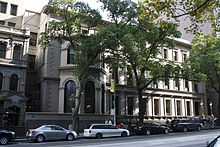Melbourne Club

The Melbourne Club is a men-only private social club established in 1838 and located at 36 Collins Street, Melbourne; adjacent to the women-only Lyceum Club. The club has up to 1,500 members; admission being by invitation only. The club is among those that have traditionally been perceived by critics as wielding a disproportionate influence on Australian public life, with a third of its members being listed in an issue of Who's Who in Australia.[1]
The club was established at a gathering of 23 Victorian squatters and businessmen in 1838 and initially used John Pascoe Fawkner’s public house on the corner of Collins Street and Market Street. The club's early years were marked by drunkenness, duels,[2] fist fights and oafishness.
At the rear of the Club building is a private courtyard garden which is the location of garden parties and private functions. In 2000 there was a dispute over a high-rise re-development of the Naval and Military Club at the rear of the two clubs in Little Collins Street. The development causes overshadowing and overview of the private garden.[citation needed] The Melbourne club building is of architectural significance as a rare intact example of a nineteenth-century purpose-built clubhouse in the Victorian Renaissance style.
Notable members
Frederick Powlett (1811-1865) was a founding member in 1838 as well as being a founding member and the first recorded president of the Melbourne Cricket Club in 1838. He was a public servant, a police magistrate and later chief commissioner of Crown Lands.[citation needed]
Membership included Governors General Sir Isaac Isaacs, Sir Ninian Stephen, Archbishop Peter Hollingworth; Governors of Victoria Sir Henry Winneke, Sir James Gobbo, the Hon Alex Chernov AC; Chief Justices of Australia Sir John Latham, Sir Owen Dixon; High Court Justices Sir Daryl Dawson and Kenneth Madison Hayne AC; Chief Justices of Victoria Sir William Foster Stawell, Sir William Irvine, Sir Frederick Mann, Sir Edmund Herring, Sir Henry Winneke and Sir John Young; Prime Minister Malcolm Fraser, politicians Sir John Bloomfield, Andrew Peacock, Admiral Sir William Bridges; Generals Sir Brudenall White, Sir William Johnston, artists Sir Arthur Streeton and Sir Daryl Lindsay; mining magnates Sir James Balderstone, Hugh Morgan, BHP-Billiton businessman Don Argus, and former head of Shell Australia and vice president of the International Olympic Committee Kevan Gosper.[3]
References
- ↑ Farouque, Farah (16 January 2009). "Into the secretive world of men only". The Sydney Morning Herald. Retrieved 24 February 2010.
- ↑ "Carrington v. Hogue, 1840". Sydney Herald. 24 October 1840. Retrieved 24 February 2010.
- ↑ "Exclusive clubs feud over highrise plan". ABC Radio. 15 February 2000. Retrieved 24 February 2010.
Coordinates: 37°48′49″S 144°58′21″E / 37.81361°S 144.97250°E